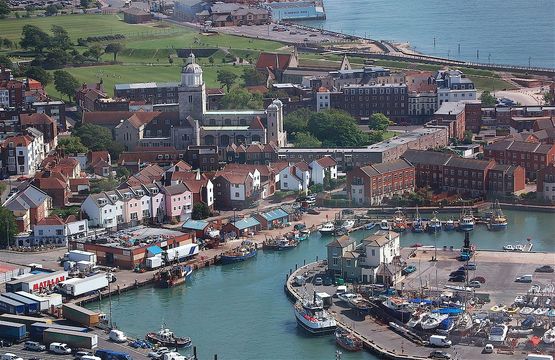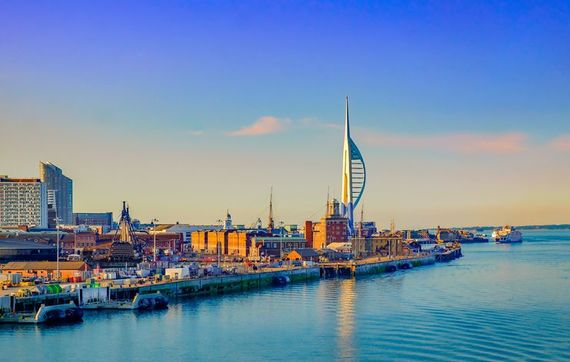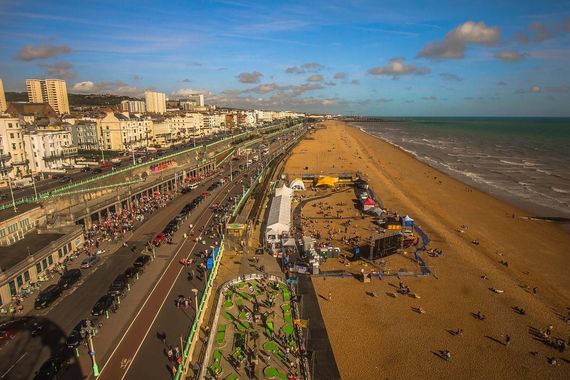
Old Portsmouth. eNil / CC
The coast of Britain! This is looking through a kaleidoscope of English history and a window into the English soul.
From the Bronze Age, the English Channel has been island Great Britain’s principal connection to the wider world. The coast facing Continental Europe has also been England’s greatest vulnerability. Over and again from prehistory the coast has been invaded and fortified against invasion – by Romans, Saxons, Vikings, Normans, Spanish, French, Germans, and smugglers.
At the same time, it's south, southeastern exposure provides sunny seaside resorts, mild climates, and fertile farmland. Here is an easy, adventurous road trip from Portsmouth, Hampshire, across West and East Sussex to the Kent port of Dover. It is a route of diverse, beautiful land and seascapes, castles and coastal forts, seaside playgrounds, and battlegrounds.
Day 1 - Portsmouth
It’s an easy drive down the A3 from the M25, and Portsmouth Harbour is clearly signposted. Or take the train from London Victoria and pick up a car there.

Portsmouth.
Do plan a full day in Portsmouth, much of it at Portsmouth Historic Dockyard. Get the big picture, however, with an overview of Portsmouth Harbour, home of the Royal Navy, and views across the Solent to the Isle of Wight from Spinnaker Tower on Gunwharf Quays. You can’t miss it. At the historic dockyard, see three of the nation’s historic warships (Mary Rose, HMS Victory and HMS Warrior), as well as the National Museum of the Royal Navy. Step aboard an excursion boat for a guided harbor tour, too, past mothballed destroyers, commercial docks and the latest ships in the Royal Navy arsenal. Portsmouth Cathedral, Southsea Castle and the D-Day Museum are also great visits.
A warren of shops, restaurants and pubs right on the water, Gunwharf Quays makes a great place to return to in the evening.
Day 2 - East Along the Coast to Brighton

Brighton coast promenade.
The main route east is the A27. Many times, however, in order to be right on the coast, plan to divert along the way. It’s a short drive on the A27, though, to the charming, overlooked cathedral city of Chichester. On the outskirts, you might visit Fishbourne Roman Palace, among the best-preserved Roman ruins in Britain, highlighting elegant floor mosaics. Founded as a cathedral in 1075, Chichester Cathedral is known for its stand-alone bell tower and a superb stained glass window over the high altar executed by Marc Chagall.
Continuing on the A27 leads to Arundel, a popular market town spread under the battlements of Arundel Castle, the palatial residence of the Duke of Norfolk. It is among the finest castle-cum-stately home visits in Britain. You might also walk the boardwalks of the Wildfowl and Wetlands Centre on the River Arun. Join up with the A259 at Worthing.
If you’d rather follow the coast, take the A259 to Bognor Regis, the original kiss-me-quick seaside resort and site of the first Butlins holiday camp. Follow the coast through Littlehampton and Shoreham-by-Sea to Brighton.
Day 3 - Unforgettable Scenes by Land and Sea to Eastbourne

The pier at Eastbourne.
Just an hour by train from London Victoria, Brighton has been southern England’s most popular beach holiday destination for generations. George IV as Regent made it all the rage in the early 1800s and built an oriental-tinged palace for himself known as the Royal Pavilion. If time permits, do take a day over in Brighton to see the Pavilion, explore Brighton Pier and beachfront, and wander in the famous Lanes of antique shops.
When it is time to move on, continue east on the A27 that routes a few miles inland to the historic market town of Lewes. You might visit the Tudor Anne of Cleeves House or the remains of historic Lewes Castle. At the White Hart Hotel on the High Street, in the 1770s Thomas Paine defended the principles of American liberty in regular debates. Catch lunch and soak up the sun on the hotel’s back deck with charming views over the South Downs.
Carrying on east half a dozen miles, literary folks will want to stop at Charleston Farmhouse, the infamous country retreat of Virginia Woolf and the Bloomsbury Group of writers. Just a few miles farther on, take the signposted road south along the Cuckmere Valley to Alfriston. Just off the picturesque village square, the Alfriston Clergy House is a timber-framed Wealden farmhouse built in 1350 – the first property acquired by the National Trust in 1896.
Join the A259 running across the limestone cliffs known as the Seven Sisters and Beachy Head to the more sedate and elegant seaside resort of Eastbourne. Do walk the floral beachfront promenade and out onto Eastbourne’s pier.
Day 4 - East Sussex and 1066 Country
The next large town along the coast is Hastings, hung below and hugging limestone cliffs. Hastings Castle sits on top, while its newly rebuilt pier and fishing fleet anchor the shingle beach. The town is famed for the Battle of Hastings, of course, but history buffs might want to detour a few miles inland to where the history-changing battle between Duke William of Normandy and Saxon native King Harold actually occurred. In the small town of Battle, Battle Abbey stands on the field and commemorates as well as illuminates what transpired there in 1066.
Returning to the A259, carry on to popular Rye, one of the original Cinque Ports and generally considered among the prettiest small towns in England. Park along the riverfront by the fishing boats and climb cobbled Mermaid Street to legendary 12th-century Mermaid Inn. Nearby, visit Lamb House, over the years home to Henry James, Joseph Conrad, H.G. Wells, and E.F Benson. Rye abounds in smaller hotels, B&Bs, restaurants, and pubs. This makes a great place to spend the evening.
Day 5 - The Coast of Kent to Dover

The Cliffs of Dover.
Back on the A259, just outside of Rye you cross from East Sussex into Kent – and onto the flat, wind-swept expanse of Romney Marsh. At New Romney, follow the signposting a few miles to Dungeness. Here at the point of the Strait of Dover, a broad, deserted shingle beach runs for miles. There’s a café at the terminus of the miniature Romney, Hythe and Dymchurch Railway.
After rejoining the A259, at Hythe you might catch a ride on the RH&D, traveling the 13 miles along the coast, through back gardens and marshland to Dungeness and back in open-air carriages.
Passing through (or stopping to explore) seaside Folkestone, take the A20 along the coast to the White Cliffs of Dover and Dover Castle. If time permits, you can certainly carry on a day or two along the coast of Kent to Broadstairs and Margate and along the Thames estuary. Or from Dover, take the A2 about 20 miles west to Canterbury and so back toward London.





Comments